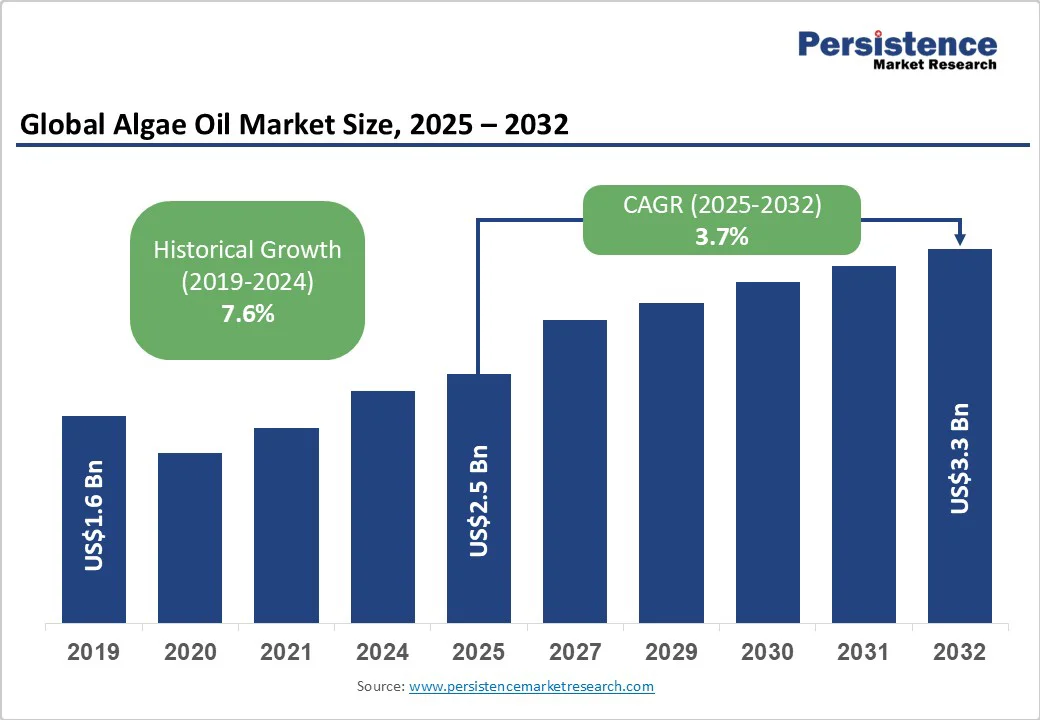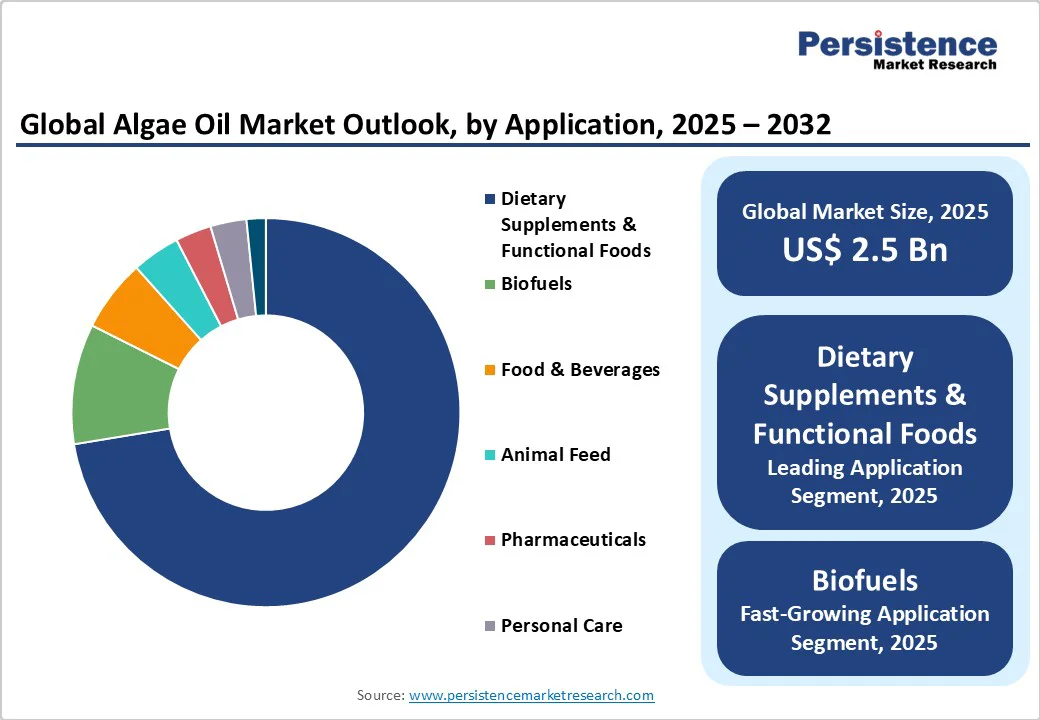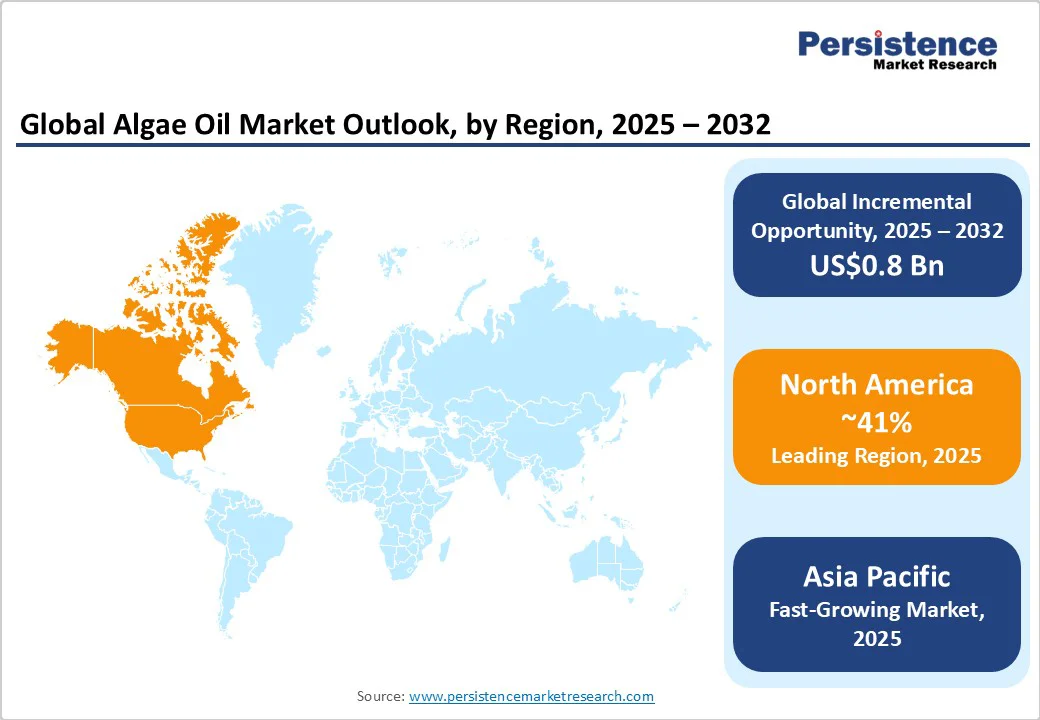ID: PMRREP12478| 188 Pages | 9 Oct 2025 | Format: PDF, Excel, PPT* | Food and Beverages

The global algae oil market size is likely to be valued at US$2.5 Billion in 2025 and is estimated to reach US$3.3 Billion by 2032, growing at a CAGR of 3.7% during the forecast period 2025 - 2032, driven by an increased demand for plant-based omega-3 fatty acids, growing acceptance of dietary supplements and functional foods, and a heightened focus on sustainable fuel production.
Market momentum is fueled by advances in algae cultivation and extraction, along with supportive clean-label regulations. These trends are driving investments across food, nutraceutical, personal care, and biofuel industries, positioning algae oil as a key ingredient in sustainable bio-based products.
| Key Insights | Details |
|---|---|
| Algae Oil Market Size (2025E) | US$2.5 Bn |
| Market Value Forecast (2032F) | US$3.3 Bn |
| Projected Growth (CAGR 2025 to 2032) | 3.7% |
| Historical Market Growth (CAGR 2019 to 2024) | 7.6% |

Rising consumer demand for plant-based nutrition is accelerating the adoption of algae/algal oil as a primary source of omega-3s, particularly EPA and DHA. With growing concerns over declining fish stocks and contaminants in marine-derived omega-3s, algae/algal oil is emerging as a sustainable and clean-label alternative for the nutraceutical and food industries.
Endorsements from global bodies such as the WHO and FAO have further validated the need for scalable plant-based omega-3 solutions. As a result, industry leaders are investing in algae oil supply chains to reduce dependency on fish oil, stabilize sourcing, and future-proof health product portfolios.
Technological advancements are also transforming algae oil economics. Closed-loop photobioreactor systems and genetic strain optimization are boosting yields and reducing land and water usage compared to traditional oilseed crops. Enhanced extraction techniques now deliver higher-quality outputs for diverse applications.
The U.S. Department of Energy-backed research and National Renewable Energy Laboratory data suggest next-gen systems can improve output by up to 30%, cutting production costs. Industry groups such as the Algae Biomass Organization are fostering collaboration and innovation through open data and pilot scaling.
Producers leveraging digital controls and advanced analytics are gaining operational efficiencies, securing long-term contracts, and building competitive advantage as the plant-based omega-3 market expands.
Commercial production of algae/algal oil faces significant cost hurdles, primarily due to capital-intensive photobioreactor systems, controlled environments, and novel harvesting methods, accounting for up to 40% of operational expenses in early-stage facilities, per the U.S. Department of Energy.
These high costs elevate algae oil prices, limiting adoption in cost-sensitive sectors such as animal feed and biodiesel. Although yield improvements and scale efficiencies are helping, further innovation in strain optimization and downstream processing is essential to unlock broader market potential.
Regulatory complexity creates further complications. Algae oil faces inconsistent global treatment, with varying GRAS (Generally Recognized as Safe) statuses and safety documentation requirements across markets. These inconsistencies slow product approvals, especially in emerging economies with evolving food standards.
Additionally, variable oil compositions, driven by feedstock or environmental conditions, complicate quality control, raising risks of non-compliance or recalls. Strategic navigation of regulatory landscapes is critical to protect brand integrity and ensure smooth market entry.
A significant opportunity is emerging in the formulation of high-purity algae oil blends for infant nutrition and medical applications. Algal-derived DHA is increasingly regarded as a gold standard in supporting cognitive and visual development in early childhood, with growing endorsement from pediatric health authorities.
The infant formula and pharmaceuticals segment is projected to account for 27.6% of the market by 2025, driven by rising demand for specialty formulations. Regulatory shifts, particularly in Europe and Asia Pacific, mandating minimum DHA levels in baby food and clinical nutrition, are expected to generate over US$300 Million in incremental revenues by 2032.
Premium players investing in precision fermentation, microencapsulation, and rigorous process traceability stand to gain a competitive edge in this high-value segment.
The global push for decarbonization is unlocking downstream opportunities in sustainable fuels. Algae oil is being explored as a viable feedstock for sustainable aviation fuel (SAF), biodiesel, and biochemicals, aligning with climate policy mandates across major G20 economies.
Regulatory support, including carbon credits and fuel blending mandates, is catalyzing R&D into scalable algae-to-energy solutions. The U.S. EPA and IEA project algae-derived fuels could surpass US$500 Million by 2030, with pilot deployments accelerating through strategic alliances with energy firms, OEMs, and policy bodies.
The food grade algae oil segment is expected to robustly lead the market, commanding an estimated 50.0% revenue share in 2025. This dominance is largely attributable to the rising integration of algae oil in dietary supplements, functional foods, fortified beverages, and medical nutrition products.
Food grade algae oil has gained broad regulatory acceptance across key geographies, including North America and Europe, where consumer demand for natural, plant-based ingredients continues to intensify. The premium positioning of food grade oils is supported by comprehensive safety profiles and clinical validation, empowering ingredient suppliers to secure higher pricing and longer-term supply contracts with global nutrition brands.
Fuel grade algae oil, while smaller in current share, is anticipated to register the fastest CAGR for the 2025 - 2032 period. Government mandates for renewable fuels, particularly in the aviation and marine sectors, alongside industry commitments to reduce carbon footprint, are incentivizing investment in fuel-grade algae oil production.
Scale-up efforts enabled by technological advancements in extraction and cultivation are gradually improving unit economics for fuel grade oils. This growth trajectory indicates the potential of fuel grade algae oil to enlarge its footprint by penetrating new industrial markets and diversifying revenue streams away from the more regulated food sector.
Within applications, dietary supplements and functional foods are projected to contribute approximately 72.4% of the market revenue as of 2025. This overwhelming share is boosted by the widespread consumer adoption of omega-3-enriched products targeting cardiovascular, cognitive, and ocular health benefits.
The rise in vegan and flexitarian dietary patterns globally is stimulating demand for plant-derived omega-3s, positioning algae oil as a preferred alternative to fish oils, especially in health-conscious demographics. Regulatory endorsements and health authority recommendations further solidify market confidence, fostering product innovation and line extensions in this space.
The biofuel application segment is projected to register the fastest growth for the forecast period 2025 - 2032. The buildout of global clean energy policies and renewable fuel standards is catalyzing increased industrial uptake of algae oil as a sustainable feedstock for biodiesel and sustainable aviation fuel.
Strategic alliances across the petrochemical and aviation sectors are enabling commercial pilot projects and expanding offtake agreements. The commercial viability of algae oil-based biofuel is expected to improve steadily as production scale expands, and ongoing research enhances conversion efficiency.
Microalgae will remain the primary source type for algae oil products, constituting approximately 80.0% of the market share in 2025. The selection of microalgae is based on their higher productivity rates, easier genetic manipulation potential, and superior lipid profiles, which meet stringent nutritional and functional quality requirements.
Industry players are investing substantially in proprietary microalgae strains, which are patented and backed by clinical research, thus generating competitive differentiation and enabling tailored product offerings across dietary supplements, infant nutrition, and cosmetic applications.
Macroalgae are anticipated to experience the fastest growth rate between 2025 and 2032. Innovations in seaweed farming techniques, environmental sustainability practices, and efficient extraction technologies are unlocking its potential for diverse end-users, including bioplastics, specialty chemicals, and aquafeed. Coastal geographies with robust marine ecosystems and favorable policy frameworks, such as parts of Asia Pacific and Europe, are expected to drive the development and commercial utilization of macroalgae-derived oils.

North America is projected to consolidate its market leadership position with an estimated 41.3% of the algae oil market share in 2025. The U.S. is the main growth engine, benefiting from sophisticated R&D infrastructure, supportive regulatory frameworks, notably by the FDA’s GRAS approvals, and a highly health-conscious consumer base demanding innovative plant-based nutraceuticals. Investments in algae cultivation technologies, including major government grants and private equity infusion, are accelerating the scale-up of cost-efficient production methods.
Regulatory incentives, such as renewable fuel standards and bio-based product tax credits, are fostering growth in biofuel applications. The competitive landscape is characterized by a concentration of well-established multinational players vertically integrated from algae strain development to ingredient distribution.
Market expansion strategies include partnerships with food and pharmaceutical companies and increasing the commercialization of new DHA-rich and specialty oil products tailored to regional consumer preferences and regulatory expectations.
Europe is expected to hold a 27.3% share of the algae oil market in 2025, ranking as the third largest regional market. Germany, the U.K., France, and Spain are leading countries, driven by evolved consumer awareness regarding clean-label natural ingredients and stringent regional regulations on food safety and environmental sustainability. Harmonized frameworks of the European Union (EU) have enabled smoother market access, accelerating product launches across dietary supplements, infant nutrition, and cosmetic segments.
The incentives under the Renewable Energy Directive are also creating complementary growth pathways, with Germany posting the highest regional CAGR over the forecast period. The EU’s regulatory regime places emphasis on traceability and certification, with investment directed toward sustainable supply chains and eco-labeling.
Public-private partnerships and Horizon Europe funding are fostering innovation in algae farming and bioproduct manufacturing, supporting resilience in the domestic industry. The competitive landscape reflects a mix of legacy biotechnology firms and emerging ventures, poised to capitalize on regional consumer preferences and evolving bioeconomy initiatives. Cross-border collaboration and pipeline diversification are core components of market strategies among key players operating in Europe.
Asia Pacific is anticipated to emerge as the fastest-growing regional market for algae/algal oil. China, Japan, India, and ASEAN countries are spearheading expansion fueled by rising awareness about biofuels, increasing health expenditure, and proactive government policies supporting algae cultivation as part of marine resource management and rural development programs.
The regional market is also witnessing expanding investments in large-scale algae farms, vertically integrated manufacturing, and cross-border technology licensing agreements. Japan and South Korea lead product innovation with a focus on high-value dietary supplements and nutraceuticals, while India is fostering demand for cost-effective animal feed applications and aquaculture supplements, enhancing its agribusiness sector.
Regulatory improvements, including food safety standard enhancements and streamlined approvals tailored for natural ingredients, are facilitating quicker market access. Investment trends indicate the proliferation of manufacturing hubs across Asia Pacific focused on export-oriented product lines, primarily targeting North American and European consumers. The robust combination of manufacturing scale, consumer health awareness, and favorable policies positions Asia Pacific as an indispensable market growth driver for algae oil globally.

The global algae oil market is moderately concentrated, with the top five players expected to hold around 50.0% of total market share in 2025. Key players such as Koninklijke DSM N.V. and Corbion N.V. dominate the functional nutrition segment through vertical integration, proprietary strains, and global manufacturing capabilities. The market blends established multinationals with agile, venture-backed disruptors, driving innovation and price competitiveness.
Business models emphasize co-branding, sustainability certification, and collaboration with supplement brands. While regional fragmentation remains in emerging markets, leaders are strengthening their positions via digital scalability, novel ingredient development, and proactive regulatory alignment to secure long-term market relevance.
The algae oil market is projected to reach US$2.5 Billion in 2025.
The algae oil market is driven by increased demand for plant-based omega-3 fatty acids, growing acceptance of dietary supplements and functional foods, and a heightened focus on bio-based fuels.
The algae oil market is poised to witness a CAGR of 3.7% from 2025 to 2032.
Technological advancements in algae cultivation and extraction, as well as regulatory alignment around clean-label, health-promoting ingredients, are key market opportunities.
Koninklijke DSM N.V., Corbion N.V., and Cargill, Incorporated are some of the key players in the algae oil market.
| Report Attribute | Details |
|---|---|
| Historical Data/Actuals | 2019 - 2024 |
| Forecast Period | 2025 - 2032 |
| Market Analysis | Value: US$ Bn |
| Geographical Coverage |
|
| Segmental Coverage |
|
| Competitive Analysis |
|
| Report Highlights |
|
By Grade
By Application
By Source
By Region
Delivery Timelines
For more information on this report and its delivery timelines please get in touch with our sales team.
About Author